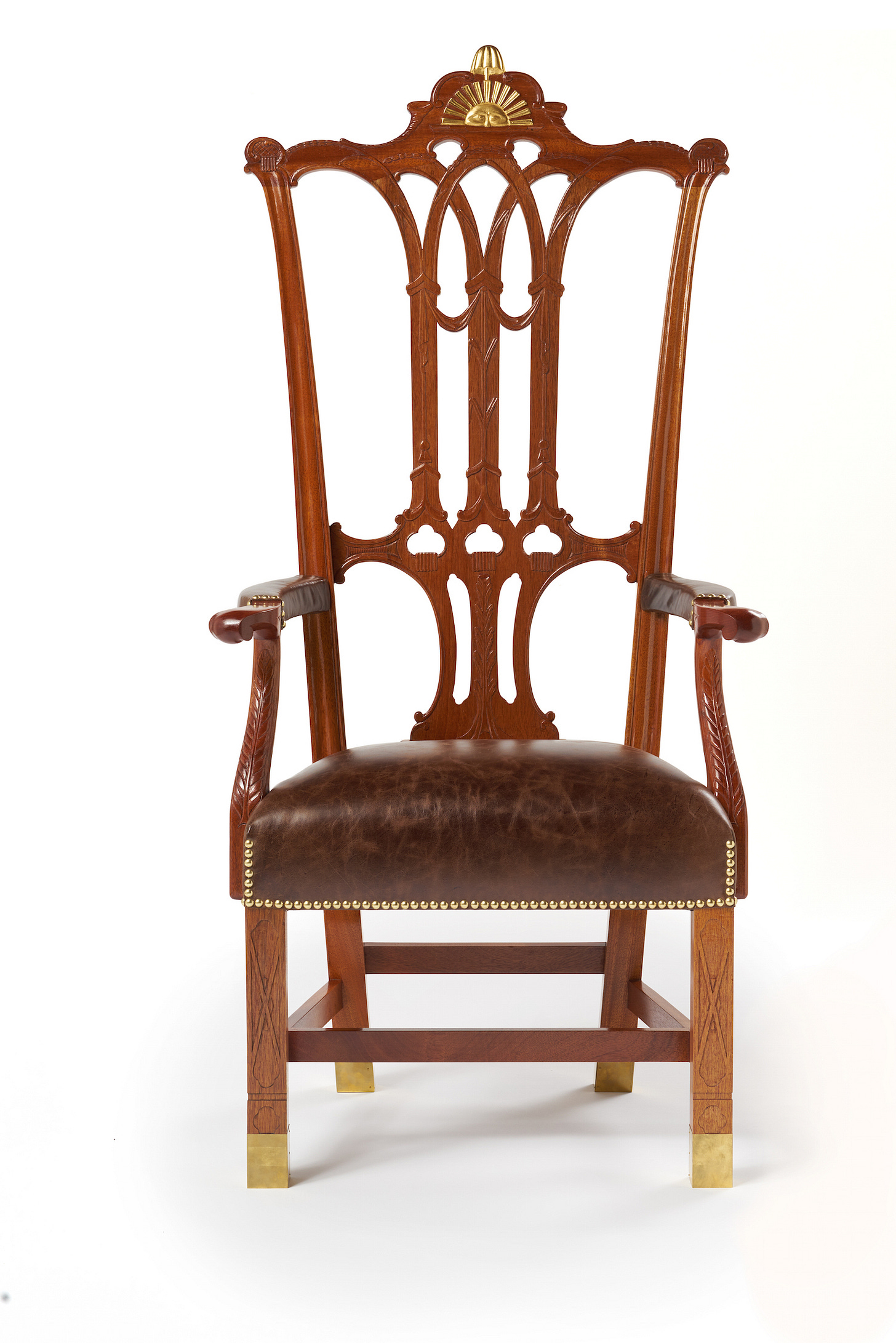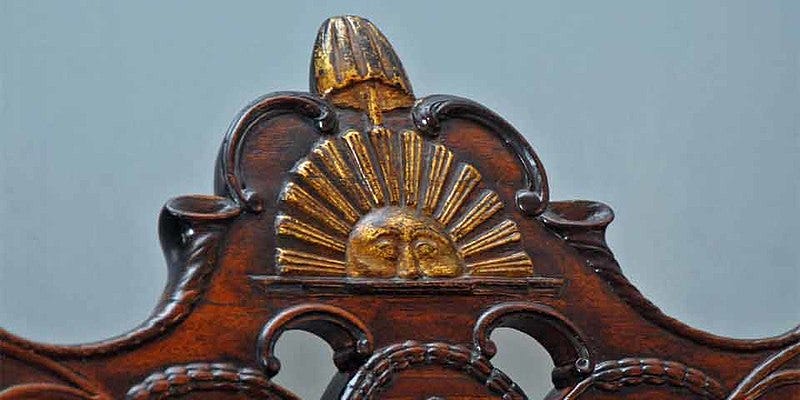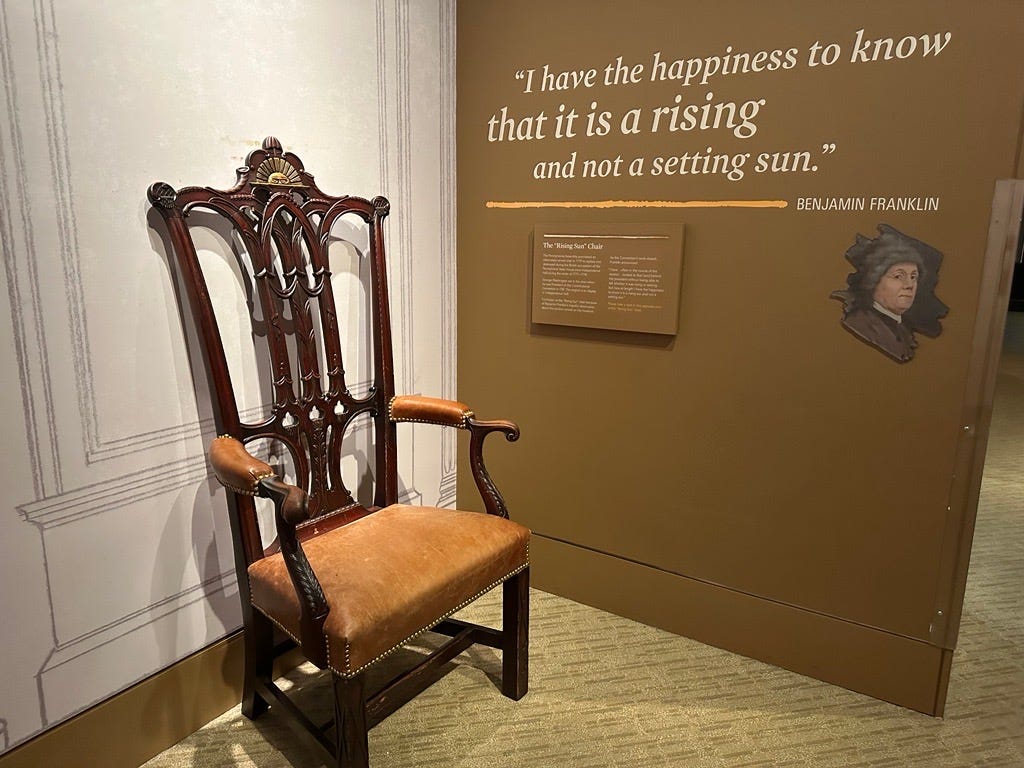America's Rising Sun Moment
Maybe we just need a change in perspective.
America’s Rising Sun Moment
Welcome to The Preamble, a newsletter that gives you the history behind and the and context about things that matter.
Our ongoing series about Project 2025 will return soon. Today, a foray into some history that’s been perching in my field of vision.
During the summer of 1787, in which men in wool and wigs sat in a hot room arguing about their volunteer group project (sounds great, right?), George Washington sat upon a stately chair.
The chair had sturdy, simple legs, and a handsome leather seat as its foundation. Two arms provided support for Washington’s lanky appendages. The back of the chair is reminiscent of flying buttresses in Gothic architecture, pieces of carved mahogany intertwining delicately, confidently, directing the eye up to the ornament that sat behind Washington’s head.
Carved into the chair by Philadelphia cabinet maker John Folwell was half of a sun, its eyes and nose visible above the horizon. The beams of light that shine from it are confident and strong.
Perched above the sun are a liberty pole and a liberty cap – two symbols of freedom throughout history. Sheaves of wheat adorn its edges.
The chair was carved from wood harvested under appalling conditions by enslaved labor in the Caribbean.
Benjamin Franklin, the oldest member of the Constitutional Convention, and certainly one of its most wealthy, respected, and famous, had much time to consider Washington’s chair that summer. Franklin’s gout was flaring up. There was little relief from the heat. People were abandoning this volunteer group project left and right.
One of the things Franklin pondered as his eyes searched for anything interesting to entertain him – there was no one to text, no status to update, no sales to shop, no billionaire’s tweets to roll his eyes at, no Candy Crush to sneak in a few rounds of – was, “What is that sun doing?”
Do you suppose, Franklin thought to himself, that the sun on Washington’s chair is rising? Or is it setting? The chair became, in Franklin’s mind, emblematic of the entire American experiment they were undertaking.
Many days, he was discouraged by what was unfolding at the Constitutional convention. The entire endeavor seemed to be fraught with peril. Rhode Island was refusing to participate. Many men were saying things like, “I won’t sign it unless it contains a provision specific to my needs.” Whether it was going to remain permissible to enslave other humans, and what role they might play in things like proportional representation, created a constant undercurrent of tension.
Some men insisted on talking far too much, thinking themselves wiser than the rest. And still, Washington sat upon his mahogany chair, presiding over the convention, but participating little.
(Washington would later go on to direct the people he enslaved to plant mahogany trees at Mount Vernon. The trees all died.)
In September 1787, when the Constitution had been drafted and it was now time to convince people that signing it was the right move, Franklin wrote a speech that he was not able to deliver. Instead, he handed it to James Wilson, who read his sentiments aloud.
Franklin said that he didn’t entirely approve of the Constitution at present, but he wasn’t sure if he ever would. He realized that he was old and he had experienced many instances of being forced to change his opinion once he had better information. “Opinions,” he said, “even on important subjects, which I once thought right, but found to be otherwise.
“It is therefore that the older I grow, the more apt I am to doubt my own judgment and to pay more respect to the judgment of others,” he said. “Most men think themselves in possession of all truth, and that wherever others differ from them it is so far error.”
Strange, Franklin quipped, that he had met no one but himself who was always in the right.
Franklin is remembered kindly in history, despite his foibles and flaws, in part because of his humility and willingness to change his mind when presented with new and better information. For his constant desire, not to show off his intellectual prowess (which was great), but to engage in self reflection in an effort to improve. He encouraged people to “doubt a little in their own infallibility.”
At the end of the convention, after serious soul searching, Franklin reflected on the mahogany chair that represented the American experiment itself. The simple base that soared into an intricate, interwoven design, topped with the golden cap of liberty. The entire of which was made possible by the labor of the enslaved.
“But now,” Franklin said, “I have the happiness to know that it is a rising and not a setting sun.”
That was America’s rising sun moment, born of travail and conquest. The rays of a faraway star smiling on what would become one of the flawed, but greatest, experiments in humankind.
We too have the opportunity to look at the challenges we face – of which there are many – with two lenses: is this America’s setting sun moment? Is it lights out for American democracy?
Or is this our rising sun moment? Is this the moment that future historians will point to on the timeline and say, “That was it. That was when Americans decided to move forward with courage, when they decided to step into the role that democracy demands: that of active participant, not of passive bystander.”
I believe it is the latter. That Americans can and will turn and face the rising sun, to let its warmth shine upon their faces.
This can be another sunrise in American history. If we choose to make it so.
I’d love to hear your thoughts in the comments. Do you have hope that this can be America’s rising sun moment?
I don’t work for a corporate news organization, nor do I have investors. This publication is entirely supported by people like you. If you enjoyed this, hitting the subscribe button is a great way to show you care.







Wow, Sharon. This might be the most beautiful writing we have seen from you so far. I am in tears this morning. Turning my head toward the rising sun. PLEASE let that be how we react to this moment. Thank you for this beautiful edition of The Preamble.
Once again, Sharon relates a very interesting and timely bit of history that I wager most of us were unaware of. It is yet more proof of the maxim that history repeats itself because here we are again at an existential crossroads for the great American experiment. We won’t know until after November if the sun is ascending or descending. I have hope for the former, justified or not but I believe hope is not enough, not when so much is at stake. I’m here in this community and others, because I hope, by reading these newsletters, exchanging comments and countering misconceptions and misinformation with facts, people will vote for the sun. I was a member of one political party for 48 years. Then I started to pay more attention, research more and listen more. I discovered some of my opinions were not based on facts. Instead of sinking further into denial or seeking the comfort of like-minded people, I simply changed my opinions. Personally, the process is a little uncomfortable but a small price to pay for the good of the country and the well-being of us all. I hope Sharon takes a look at the major issues on voters’ minds over the next five months and we get into some good fact-based discussions about them.